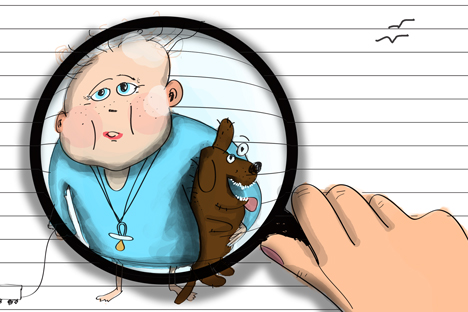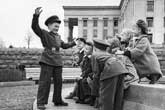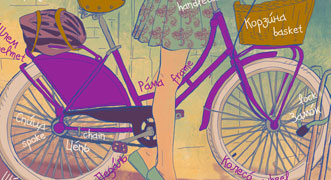From rug rat to hipster: slang names for kids and teenagers

Click to enlarge the cartoon. Drawing by Niyaz Karim
Most nicknames that parents give to their children are born out of love. The words кроха – krokha (babe) and малютка – malyutka (little thing) highlight the small size of a young child, while the word карапуз – karapuz (toddler), his or her clumsiness. There is also спиногрыз - spinogryz (rug rat).
On the other hand, some nicknames speak less of love and on first hearing sound even insulting: сопляк – soplyak (snot), щенок – shenok (puppy), шпингалет – shpingalet (literally, a window latch). Most neutral and widely used term of endearment for a child is мелкий melky - (kiddo).
At school, children gradually fall into different groups depending on their academic performance. In Russian, those who do well in their studies are called отличники (otlichniki) while those who underperform are termed двоечники (dvoychniki) and троечники (troychniki), which are names deriving from the words two and three, the below-the-average and average grades in the five-grade system used in Russian schools.
Those pupils who fail a school year and have to repeat it are known as второгодники (vtorogodniki). High achievers at school (the отличники) are favorites with parents and teachers alike, while other pupils are not always fond of them and call them ботаники (botaniki) or выскочки (vyskochki - smarty-pants). For their part, grown-ups and people of authority sometimes describe unruly students as хулиганы (hooligani - hooligans) and шпана (shpana - hoodies).
During the Soviet era, terms for schoolchildren were based around the history and ideology of the Soviet state. In the first grade, children became октябрята (oktyabryata), in reference to the Bolshevik Revolution of October 1917 Bolshevik Revolution).
At the age of 10, they were promoted to пионеры (pionery - pioneers). Officially, only the best kids could become members of the Pioneer organization, although in practice almost everybody, perhaps with a rare exception of the worst hooligans, became пионеры.
At the age of 14, children graduated from the Pioneer Organization and had the option of joining the Communist Youth League, the Komsomol, and be called комсомолец (komsomolets). Although membership in the Komsomol was optional, most teenagers in the Soviet Union joined it, believing that to do otherwise would jeopardize their future career paths.
Until the late 1980s, no other formal youth organizations were allowed in the Soviet Union. During perestroika, several alternative youth movements appeared.
Their members became known as неформалы (neformalny - literally, non-formal). In fact, many of those movements had existed for at least 30 years, but they were either ignored or vilified.
The first such movement to emerge, in the 1950s, were стиляги (stilyagi), which was a term derived from the word style and meant basically fashion-conscious. These стиляги tried to stand out from a uniform gray mass of Soviet people by wearing bright (preferably Western) clothes and listening to jazz and rock-n-roll.
Since it was practically impossible to get access to real foreign records, music was copied on radiographs, with the resulting recordings called "music on bones." One of the popular propaganda slogans of the day said: "Today he is playing jazz and tomorrow he will betray his motherland."
In the 1970s, stilyagi were replaced by hippies (known in Russian as хипари, хиппаны, пиплы, волосатые), with their long hair, bright colored clothes and numerous small accessories (фенечки - fenechki). Hippies, more than any other movement, enriched Russian slang, mainly with borrowings from English.
Related:
Magical tales to capture younger imaginations
Key youth subcultures from Lenin to our day
For instance, an empty apartment that was free for use was called a флэт (flat). In such a place, it was possible to organize concerts or let hitchhickers spend the night (найтовать - nightovat). The authorities responded to hippies' asocial lifestyle (as well as to their penchant for exploring altered states of consciousness) by confining them for mandatory treatment in mental institutions (дурка – druka or креза - kreza).
In the 1980s, the list of informal youth groups further expanded, with the most striking of them being punks (панки - pahnki) (with their mohawk hairstyle, safety pins and chains in clothes and body piercing); and металлисты (metallisti - derived from heavy metal), who introduced the words трэш (trash) and угар (ugar) into the slang vocabulary.
This rise in largely Moscow and St. Petersburg-based youth subcultures provoked a provincial backlash in the form of гопники – gopniki or люберы - lyuberi (the latter deriving from the name of a suburb of Moscow called Lyubertsy). These were teenagers from working-class suburbs who developed a social hatred of their "fashionable" contemporaries.
The term рокер – rocker - has experienced an interesting transformation. In the late 1980s, it was used to describe those who loved rock music, whereas now рокеры are members of motorcycle clubs and their average age is well beyond the teenage years.
In the 2000s, the most visible youth subcultures were Emos (эмо) and Goths (готы), who introduced an ironic adjective готичный (gotichni), used to describe something that is at the height of current fashion and has in fact nothing to do with anything Gothic.
In the 2010s, young intellectuals in big cities across Russia began to call themselves хипстеры (hipsteri). They wear skinny jeans, plimsolls, and thick-rimmed glasses and take an interest in indie culture and amateur photography. A skill that they particularly value is the ability to do the лук – look (a selfie): take a full-length picture of oneself, projecting the "right" hipster image, and post on social networking sites.
All rights reserved by Rossiyskaya Gazeta.
Subscribe
to our newsletter!
Get the week's best stories straight to your inbox



